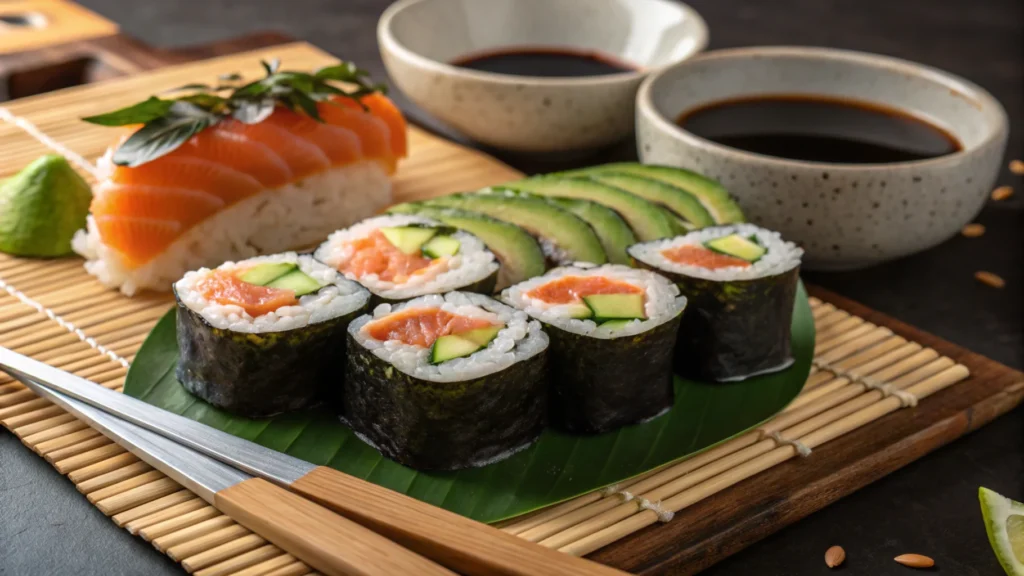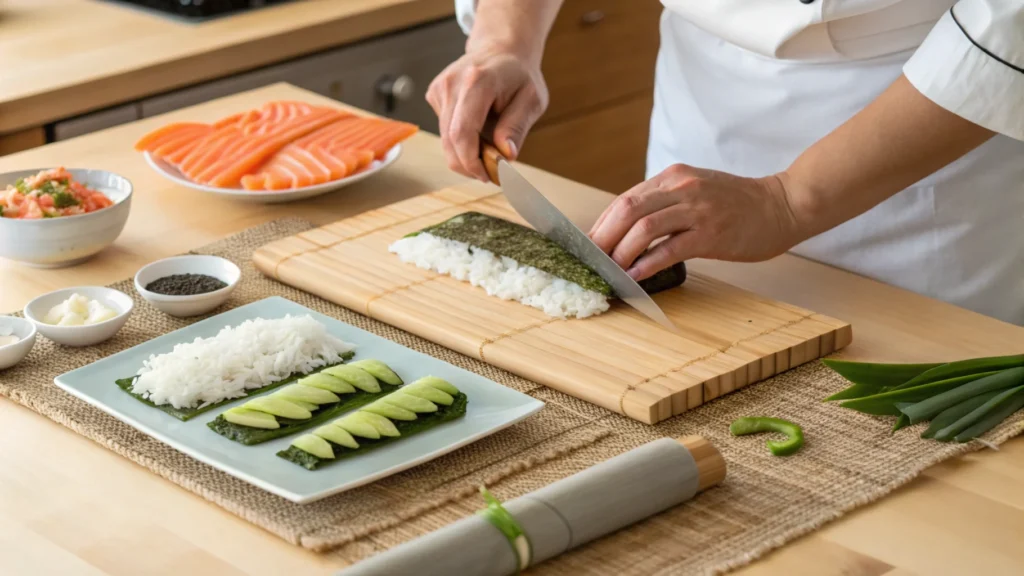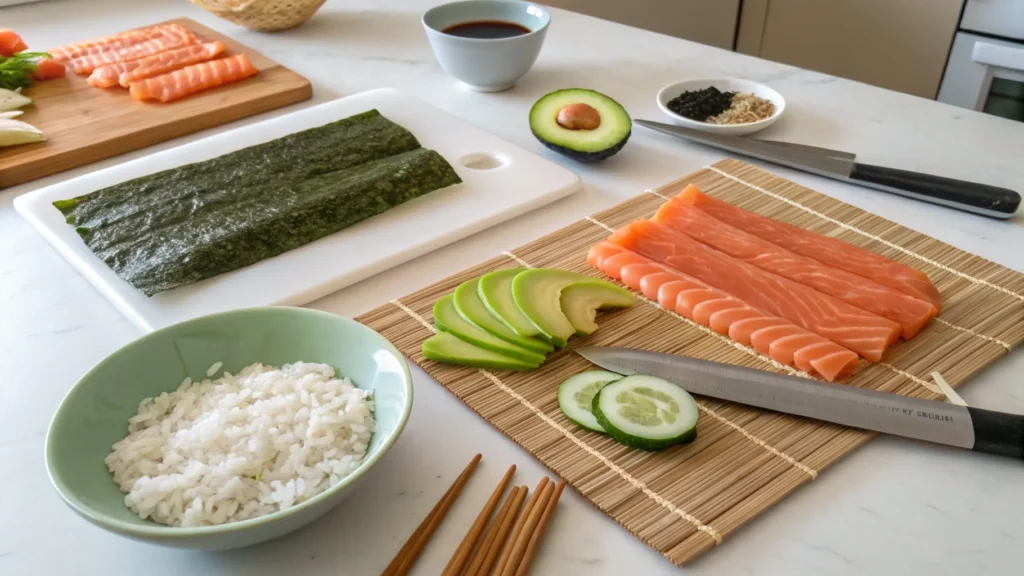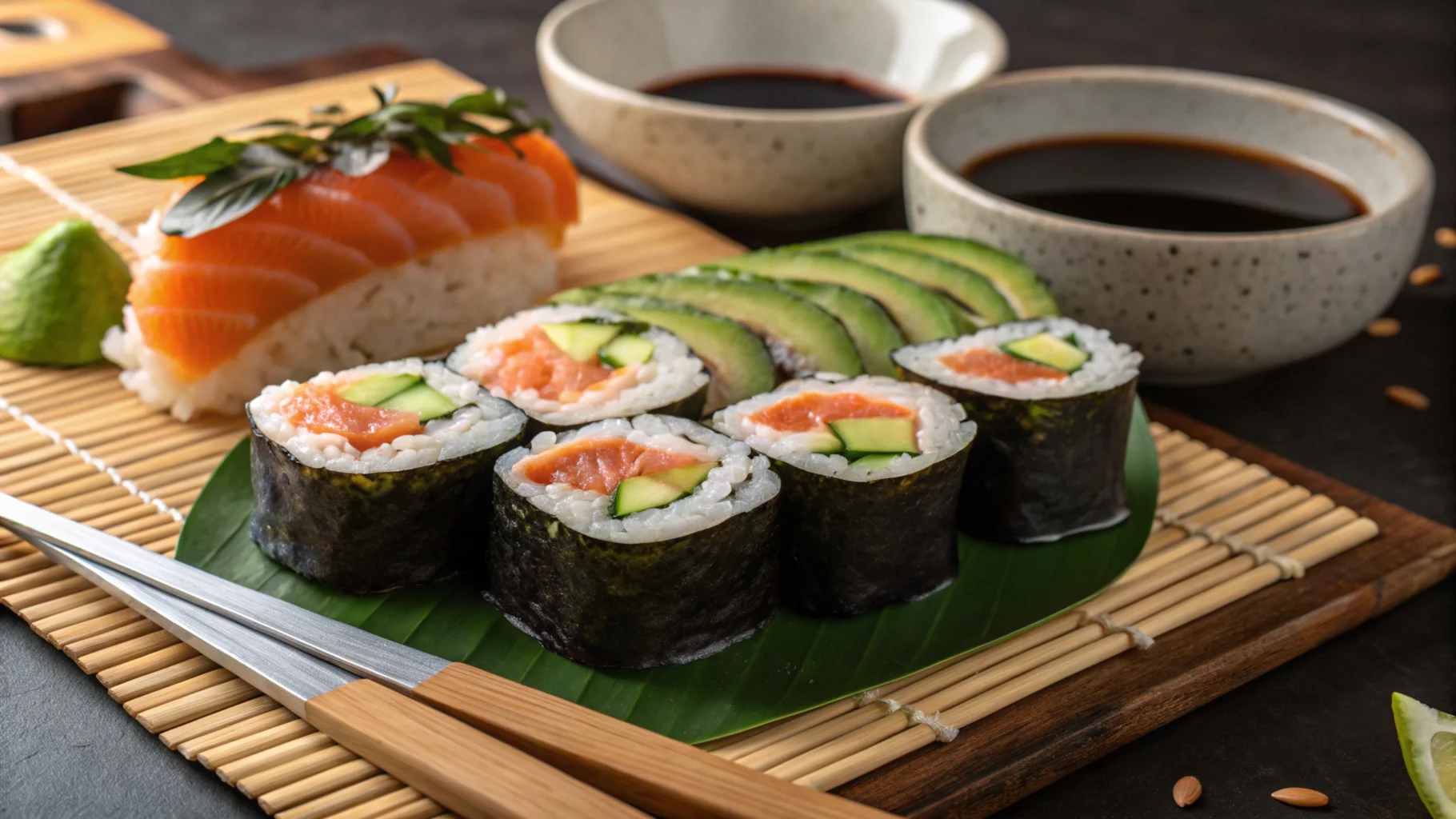Sushi and Maki Sushi are two iconic Japanese dishes that share similar ingredients like rice and fish but differ significantly in preparation and presentation. Sushi includes various styles, such as nigiri and sashimi, emphasizing simplicity and the quality of the ingredients. Maki Sushi, on the other hand, refers to rolled sushi wrapped in nori and filled with diverse ingredients, offering a more creative and versatile approach.
Understanding these differences helps you better appreciate the cultural and culinary richness of Japanese cuisine. Both sushi and maki are integral to this tradition, each contributing uniquely to its global popularity.
For related tips, check out what type of lettuce is best for lettuce wraps and elevate your cooking with fresh ideas!

Table of Contents
How Sushi Differs From Maki
While sushi and maki both originate from Japan and share some common ingredients, there are fundamental differences between them. You can see these differences clearly in how chefs prepare and serve them.
Preparation
One of the main distinctions between sushi and maki is the preparation method. Sushi is a dish made by combining vinegared rice with various toppings like raw fish, vegetables, or egg. There are different types of sushi, but they all share this base of seasoned rice.
Maki is a type of sushi roll. It involves wrapping rice, fish, and vegetables in a sheet of nori (seaweed). The roll is then cut into bite-sized pieces. Essentially, maki is a rolled form of sushi. It stands out due to its use of nori as a wrapping agent.

Ingredients
Another major difference lies in the ingredients used. Sushi can feature various toppings. These include fish, seafood, vegetables, or even egg. However, the defining characteristic of sushi is the vinegared rice. Maki, however, is characterized by its inclusion of nori, which gives the dish its unique texture and flavor.
Common ingredients in sushi include salmon, tuna, shrimp, and avocado. Maki often uses similar ingredients. However, the chef wraps these ingredients in nori to create a more compact dish. While both can contain similar items, the preparation and presentation are where the true difference lies.

Types of Sushi and Maki
There are many types of sushi and maki. Each type has unique characteristics and regional variations. Understanding these differences can help you choose the dish that suits your taste and preferences.
Sushi Types
Sushi comes in many forms, with the most popular being:
- Nigiri: A small mound of rice topped with a slice of fish or seafood.
- Sashimi: Thinly sliced raw fish or seafood served without rice.
- Temaki: A hand-rolled cone of nori filled with rice, fish, and vegetables.
- Chirashi: A bowl of rice topped with assorted fish, vegetables, and garnishes.
Each type of sushi highlights the vinegared rice as the star. The toppings can vary widely. They depend on the chef’s creativity and the ingredients available in the region.
Maki Types
Maki is also divided into different categories, such as:
- Hosomaki: Small rolls with a single filling, often tuna or cucumber, wrapped in nori.
- Uramaki: “Inside-out” rolls, where the rice is on the outside and the nori is on the inside.
- Futomaki: Larger rolls that contain multiple ingredients, including fish, vegetables, and sometimes even egg.
- Temaki: Hand-rolled cones of nori filled with rice and ingredients.
Despite differences in size and fillings, all types of maki are rolled. They are then sliced into bite-sized pieces.
Cultural Significance of Sushi vs. Maki
Both sushi and maki hold cultural importance in Japan. However, their significance varies depending on the context in which they are served. While sushi has a long history in Japanese culture, maki has emerged more recently and has gained international popularity.
Sushi
Sushi has been a part of Japanese cuisine for centuries, with its origins dating back to the 8th century. Initially, sushi was a method of preserving fish in fermented rice. Over time, it evolved into the dish we know today. Sushi is now seen as a symbol of Japanese culinary craftsmanship. It embodies the principles of simplicity and precision.
Sushi typically appears at important events or celebrations, such as weddings, festivals, and New Year’s gatherings. People also consider it a delicacy, often enjoying it at high-end sushi restaurants where the focus lies on the quality of the fish and the skill of the sushi chef.
Maki
Maki, in contrast, is more modern in its development. It emerged during the Edo period (1603-1868). Sushi became popular as street food, offering a more portable and accessible version.While sushi remains a dish associated with formality and tradition, maki has become a more casual and versatile option.
People now enjoy maki around the world, often serving it in casual settings like sushi bars, buffets, or even at home. Its popularity has grown, especially in Western countries, where variations like the California roll have adapted to suit local tastes.
Health Benefits of Sushi and Maki
Both sushi and maki offer a variety of health benefits, particularly due to their inclusion of fish, seaweed, and rice, which are rich in nutrients. However, the nutritional profile of sushi and maki can vary depending on the specific ingredients used.
Nutritional Value of Sushi
Many people regard sushi as a healthy meal option because it combines lean proteins, essential fatty acids, and complex carbohydrates from rice. The simplicity and quality of the ingredients make it a nutritious choice. Some of the key nutritional benefits of sushi include:
- High in Omega-3 Fatty Acids: Fish like salmon, tuna, and mackerel are excellent sources of omega-3 fatty acids. These fats are essential for heart health. These healthy fats help reduce inflammation, lower cholesterol, and improve cardiovascular function, making sushi a heart-healthy choice.
- Low in Calories: Many types of sushi are naturally low in calories, especially those that feature raw fish, vegetables, and minimal added ingredients. This makes sushi a good option for those looking to maintain or lose weight while still enjoying a satisfying meal. The relatively low calorie content, combined with its high nutritional value, helps keep energy levels stable.
- Rich in Vitamins and Minerals: Sushi offers a wealth of vitamins and minerals, largely due to the fish, seaweed (nori), and vegetables used in its preparation. Fish provide essential nutrients like Vitamin A (important for eye health), B vitamins (important for energy metabolism), and iodine (which supports thyroid function). Nori, the seaweed wrap, is also an excellent source of trace minerals and antioxidants, which help protect the body from oxidative stress.
However, it’s important to keep in mind that some types of sushi, especially those that are deep-fried or topped with creamy sauces, can be higher in calories, fats, and sugars. To keep it as healthy as possible, stick with simple rolls made with fresh ingredients and minimal added sauces.
Nutritional Value of Maki
Maki provides many of the same nutritional benefits as sushi, especially when made with high-quality fish, fresh vegetables, and nori. However, there are some key differences in its nutritional profile that set it apart:
- Higher Carbohydrate Content: Maki usually contains more rice than other types of sushi. This increases its carbohydrate content, which makes it a good source of energy. While the carbs in the rice are generally healthy, it may not be the best choice for those on low-carb or ketogenic diets. However, the rice in maki helps provide a satisfying feeling of fullness.
- Low in Saturated Fat: Fish such as salmon, tuna, and mackerel, commonly used in maki, contain low levels of saturated fat, making maki a heart-healthy food choice. These fish also provide rich sources of omega-3 fatty acids, which reduce inflammation, improve heart health, and support brain function. As a result, maki offers a great option for maintaining overall cardiovascular health.
- Good Source of Fiber: The nori (seaweed) used in maki is an excellent source of dietary fiber. Fiber is vital for digestion, as it helps promote healthy bowel movements, aids in weight management, and supports overall gut health. Additionally, fiber can help regulate blood sugar levels by slowing the absorption of sugar into the bloodstream, making maki a good choice for those looking to maintain stable energy levels.
While maki is generally a healthy choice, it’s important to note that certain variations, such as tempura rolls (which include fried ingredients) or rolls with creamy sauces, can increase calorie, fat, and sugar content. These additions can affect the overall nutritional profile of the dish, making it less healthy than simpler versions.
FAQs
What is the difference between sushi and maki?
Sushi refers to a variety of Japanese dishes made with vinegared rice, often combined with fish, vegetables, seafood, or even eggs. Maki, on the other hand, is a specific type of sushi where a sheet of nori (seaweed) wraps the rice and other ingredients. While people consider all maki as sushi, sushi itself includes other types, such as nigiri (a slice of fish served over a ball of rice) and sashimi (thin slices of raw fish served without rice). In short, maki describes rolled sushi, but sushi can also come in other forms.
How is maki different from sushi?
The main difference between maki and sushi lies in their preparation and presentation. Sushi refers to any Japanese dish that includes vinegared rice, often paired with fish, seafood, or vegetables. Maki is a specific type of sushi in which rice and other ingredients wrap in nori (seaweed) to form a roll. While maki is one of the most popular sushi styles, sushi also includes other forms, such as nigiri (where a slice of fish sits on top of a rice ball) and sashimi (simply raw fish without rice). Therefore, all maki is sushi, but not all sushi is maki
How is maki made?
Making maki is simple. Start by preparing sushi rice with rice vinegar, sugar, and salt. Lay a nori sheet on a bamboo mat and spread a thin layer of rice, leaving a small border. Add your fillings—raw fish, vegetables, or cooked ingredients like shrimp. Roll tightly using the mat, then slice into bite-sized pieces. For uramaki (inside-out rolls), place rice on the outside and garnish with sesame seeds or fish roe.
Where does the lemur live?
Lemurs are found only on the island of Madagascar and the nearby Comoros Islands. These unique creatures live in a range of habitats across Madagascar, from tropical rainforests to dry forests and even the spiny deserts. The island of Madagascar, isolated for millions of years, allowed lemurs to evolve into a wide variety of species, each adapted to specific environments. Lemurs in rainforests have thick fur to protect them from the humidity, while those in dry forests have evolved ways to conserve water. Despite their adaptability, habitat loss and deforestation have pushed many lemur species to the brink of extinction, making conservation efforts more crucial than ever.
Conclusion: Understanding the Unique Appeal of Maki Sushi
Sushi and maki are two celebrated dishes in Japanese cuisine that share common ingredients but differ significantly in preparation and presentation. Sushi is a traditional dish focusing on vinegared rice and fresh fish, often served with minimal additions to highlight the quality of the ingredients. Maki, a type of sushi, is rolled with nori and filled with a variety of ingredients, from fish to vegetables, making it more accessible and versatile for casual dining.
Both sushi and maki are nutrient-dense, offering lean protein and healthy fats, making them excellent choices for a wholesome diet. Understanding their differences not only deepens your appreciation for Japanese culinary artistry but also enhances your dining experience, whether you enjoy sushi in an elegant setting or indulge in a flavorful roll of maki at a sushi bar.
For a broader exploration of flavorful dishes, check out is egg foo young healthy from Chinese. This article delves into the nutritional value and unique characteristics of another iconic dish, expanding your culinary knowledge.

